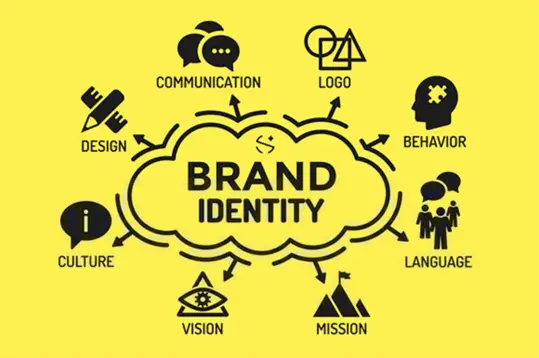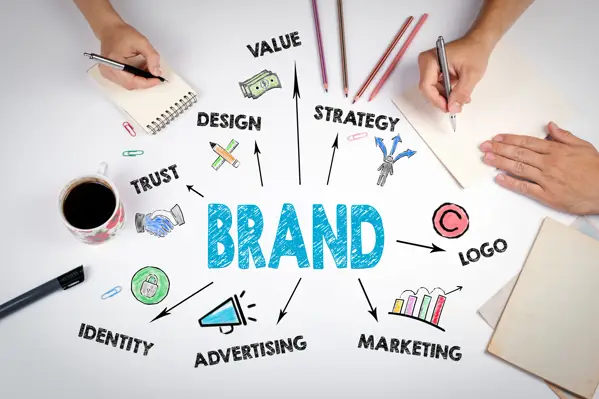What is Brand Identity? Building a Strong and Distinctive Brand
Being unique in today's cutthroat business environment is essential for every firm to succeed. The secret to accomplishing this is your brand identity. It takes more than just a catchy logo or witty tagline to build a recognizable brand that appeals to your target market. Aniday will discuss “What Is Brand Identity?” and how to create a powerful one.

What is Brand Identity?
Your brand's identity is its core, the distinctive fingerprint that distinguishes you from the competitors. It includes all of the conceptual, aural, and visual components that characterize and communicate the values of your brand. Your brand identity communicates to the public who you are, what you believe in, and why you are important.
A strong brand identity accomplishes several important goals:
-
Differentiation: It distinguishes your brand from others in a crowded market.
-
Recognition: It makes your brand memorable and instantly recognizable.
-
Consistency: It ensures a uniform message and image across all touchpoints.
-
Trust: A well-defined brand identity can foster trust and credibility.
4 Benefits Of A Strong Brand Identity
There are different benefits of a strong brand identity that you can consider:
1. Strong Branding Creates Recognition
Effective branding makes your business memorable. While some consumers carefully research their options, others choose familiar names. Established companies like Coca-Cola, Starbucks, and KFC invest heavily in advertising to capitalize on brand recognition. Even with a smaller budget, you can apply the same principles to your online marketing. A solid brand identity involves consistent font, color, and logo choices across all your marketing materials.
2. Brand Recognition Builds Trust
A well-crafted brand identity can make your business appear stronger and more trustworthy than competitors. Customers tend to place greater trust in established companies. A strong brand identity says, "We're here to stay, and we stand by our products and services." Additionally, people are often willing to pay more for established brands. A professionally branded website fosters trust and confidence in your offerings.
3. Strong Branding Filters Out Unwanted Leads
Your brand identity can act as a filter, helping you attract the right customers while deterring the wrong ones. Not everyone is an ideal fit for your business; you want customers who align with your core values. A thoughtfully curated brand identity will simultaneously attract the right audience and repel those who don't fit, making it easier to close sales and build long-term relationships with the right customers.
4. Brand Identity Supports Product Launches
No matter your industry, there are opportunities to introduce new products and services. Businesses with established, strong brands and loyal customer followings have an advantage. It's easier and more cost-effective to introduce new products to customers who already trust you than to convince strangers to try something different. Strong brand identity and consistent inbound marketing work together to cultivate enthusiastic followers who are eager to hear about your latest offerings.
How to Develop a Strong Brand Identity?

You must have a solid idea of your brand's identity before delving into the concrete components that make it up. Your brand's identity entails more than just visual appeal; it also involves the narrative you want to present and the principles you want to uphold. The following characteristics best describe your brand:
1. Your Mission (What's Your "Why?")
Your mission is your brand's purpose and reason for existence. It must respond to the query, "Why did we start this business?". Your mission statement defines the impact you aim to create in the world and the problem you intend to address. It's the guiding star that informs your every decision and action.
2. Your Values (What Beliefs Drive Your Company?)
Values are the fundamental beliefs and principles that drive your company's culture and decision-making. They shape your company's ethics, behavior, and relationships. Defining your values helps you make decisions that align with your core beliefs.
-
Your Brand Personality (If Your Brand Was a Person, What Kind of Personality Would They Have?)
-
Think of your brand as a person. What traits and characteristics would they exhibit? Is your brand playful, serious, sophisticated, or adventurous? Your brand's personality sets the tone for all your communications and interactions.
3. Your Unique Positioning (How Do You Differentiate Yourself from the Competition?)
What distinguishes your company's brand from the competition? Your distinct value proposition is a result of your distinctive positioning. It answers the question, "What can we do exceptionally well?". Discovering your unique selling proposition or distinct expertise is what sets you apart.
4. Your Brand Voice (If Your Brand Was a Person, How Would It Communicate?)
The way you speak to your audience represents your brand's voice. It's the manner in which you communicate with customers and in your marketing materials. Is your brand's voice friendly, formal, conversational, or authoritative? It ought to be in harmony with your brand's character and principles.
These components form the core of your brand identity and collectively determine your brand's personality. Prior to beginning to create your brand identity, it is essential to have a firm understanding of these components. Consider posing the following queries to yourself in order to achieve clarity:
-
Why did we initiate this business originally?
-
What are the core beliefs and values that are important to us as a company?
-
What do we excel at, making us unique in our industry?
-
What sets us apart from our competitors?
-
If you had to summarize your brand in three words, what would they be?
-
What are the three words you would want your customers to use when describing your brand?
Sometimes, a quick brainstorming session might yield insightful information about the personality of your brand. Keep in mind that developing a clear knowledge of your brand identity is a continuous process that might change as your company expands and adjusts to shifting market dynamics.
You can look into tools like branding workbooks and manuals from consulting companies and branding professionals if you need more direction in this process. For instance, PricewaterhouseCoopers provides a thorough branding workbook that, while targeted at personal branding, includes exercises and methods that may be applied to any kind of company model.
Design: The Foundation of Your Brand Identity
Your brand identity's foundation is design. Both the aesthetic elements—such as your logo and color scheme—and the practical ones—such as your website and product packaging—are involved. Here's how to approach it:
1. Developing Your Brand Design

Before you can design your brand identity, you need to establish the design principles that align with your brand's personality and values.
1.1. Typography
Typography refers to the fonts and typefaces you use in your branding materials. Different fonts can convey various emotions and messages. Choose fonts that align with your brand's character. For example, a sleek, modern font may work well for a tech startup, while a more traditional font suits a heritage brand.
1.2. Color Palette
Colors are powerful communicators. They evoke emotions and associations. Think about what feelings you want your brand to evoke and choose a color palette accordingly. For example, red can signify passion and energy, while blue often represents trust and reliability.
1.3. Form/Shape
The shapes and forms used in your branding also play a role in conveying your brand's identity. Is your brand characterized by clean, geometric lines, or does it favor more organic, flowing shapes? Your choice here should reflect your brand's essence.
2. Designing Your Brand Identity

It's time to develop the physical components of your brand identity now that you have set your design concepts.
2.1. Logo
Your logo is the public representation of your brand. It should be unique, enduring, and instantly recognizable. To design a logo that perfectly captures the essence of your brand, think about working with a professional designer. Consider how your chosen form, color scheme, and typography may all be incorporated into the logo.
2.2. Website
Website Your website is frequently a potential customer's initial point of contact with your brand. Make sure the design ideals of your brand are represented. Use the same typography, color scheme, and forms as in your other branding pieces since consistency is important. Make it responsive to many devices and user-friendly.
2.3. Product Packaging
For businesses that offer physical products, the packaging is a critical part of brand identity. It represents the initial tangible interaction customers have with your product. Make sure it aligns with your design principles, and consider how it can enhance the unboxing experience.
2.4. Business Cards
Even in our digital era, business cards retain their significance. They're a physical representation of your brand that people can carry with them. Incorporate your typography, color palette, and logo into the design.
2.5. Email Design
Your email communications should also reflect your brand identity. Use consistent design elements in your email templates to ensure that every email you send is in line with your brand image.
3. Create a Brand Style Guide

A brand style guide is a comprehensive document that outlines the guidelines for using your brand's design elements consistently. It's a reference for anyone creating content or materials for your brand, ensuring that there's no deviation from the established identity.
A brand style guide typically includes:
-
Logo Usage: Guidelines on where and how to use the logo, including variations and sizes.
-
Typography: Detailed information about the fonts and typefaces used in all materials.
-
Color Palette: Specific color codes, color combinations, and usage instructions.
-
Form and Shape: Instructions on how shapes and forms should be used in design.
-
Image Usage: Guidelines on using images and graphics in alignment with the brand identity.
-
Voice and Tone: Instructions on the language and style of communication to maintain a consistent brand voice.
By having a brand style guide, you can make sure that everyone inside your company adheres to the same design standards and upholds the integrity of the brand.
7 Brand identity examples to inspire you
Several brands have achieved outstanding and successful brand identities. These brands are known for their strong recognition, trustworthiness, and effective marketing. Here are some notable examples:
1. Apple
Apple's $3 trillion brand is synonymous with innovation, simplicity, and premium quality. Their minimalist design, monochromatic Apple logo, and user-friendly product aesthetics create a seamless and satisfying user experience.
Apple stores, with their modern tech haven atmosphere, and aspirational advertising reinforce the brand's premium perception. At the core of their brand messaging is the promise of empowering individuals through technology, epitomized by the iconic tagline "Think Different."
2. Coca-Cola

Coca-Cola's brand is a testament to consistency and positivity. Rooted in happiness, sharing, and universal connectivity, it maintains a timeless appeal. The iconic red-and-white logo and distinctive typography are instantly recognizable.
Their enduring bottle design has solidified a strong visual identity. Coca-Cola's heartwarming ad campaigns focus on moments of connection, further reinforcing their role as a brand that brings people together.
3. Nike
The "Swoosh" emblem and "Just Do It" tagline are widely associated with athletics, drive, and success. Nike's brand identity is based on encouraging aspiration and achievement among athletes and empowering them.
4. Disney

Disney is known for its magical and family-friendly brand identity. The iconic castle logo and beloved characters like Mickey Mouse reinforce this image.
5. Google
Google's brand identity revolves around simplicity, innovation, and accessibility. Its colorful logo and user-friendly products and services embody these values.
6. Amazon
Amazon's brand identity is built on reliability, convenience, and a vast product selection. Its smiling arrow logo represents customer satisfaction and continuous improvement.
7. McDonald's

McDonald's brand identity is all about fast, affordable, and consistent dining experiences. The golden arches logo and the tagline "I'm Lovin' It" reinforce this image.
Conclusion
With the article above, Aniday hopes you have understood "What is Brand Identity?" A strong brand identity is an effective tool for attracting and retaining customers. An engaging story that connects with your target audience is more important than mere aesthetics. You can create a standout brand, build trust, and make an impact by developing a clear brand identity and consistently applying it across all touchpoints.
Aniday's HR Services
Headhunting Service
Find and recruit quality candidates in just 1 week! Supported by 40,000 experienced headhunters in IT, Finance, Marketing… capable of recruiting in any region.
Headhunting Service ➔Employer of Record (EOR) Service
On behalf of your business, we recruit employees and handle payroll without the need to establish a company in markets such as Vietnam, Singapore, Malaysia, India, Indonesia…
Employer of Record (EOR) Service ➔